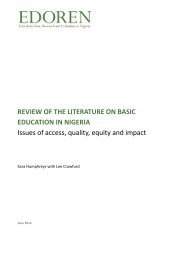review-of-the-literature-on-basic-education-in-nigeria-june-2014-3-1
review-of-the-literature-on-basic-education-in-nigeria-june-2014-3-1
review-of-the-literature-on-basic-education-in-nigeria-june-2014-3-1
You also want an ePaper? Increase the reach of your titles
YUMPU automatically turns print PDFs into web optimized ePapers that Google loves.
Review <str<strong>on</strong>g>of</str<strong>on</strong>g> <str<strong>on</strong>g>the</str<strong>on</strong>g> <str<strong>on</strong>g>literature</str<strong>on</strong>g> <strong>on</strong> <strong>basic</strong> educati<strong>on</strong> <strong>in</strong> Nigeriapositi<strong>on</strong> <str<strong>on</strong>g>of</str<strong>on</strong>g> boys school<strong>in</strong>g is for girls while bus<strong>in</strong>ess and acquisiti<strong>on</strong> <str<strong>on</strong>g>of</str<strong>on</strong>g> material wealth is for ‘real men’(Nworgu 2011, cited <strong>in</strong> UNICEF/UIS 2012).8.6.2 AlmajiraiAn excepti<strong>on</strong> to <str<strong>on</strong>g>the</str<strong>on</strong>g> dearth <str<strong>on</strong>g>of</str<strong>on</strong>g> <str<strong>on</strong>g>literature</str<strong>on</strong>g> <strong>on</strong> boys and educati<strong>on</strong> is <str<strong>on</strong>g>the</str<strong>on</strong>g> topic <str<strong>on</strong>g>of</str<strong>on</strong>g> almajirai, a product <str<strong>on</strong>g>of</str<strong>on</strong>g> <str<strong>on</strong>g>the</str<strong>on</strong>g>over-enrolment <str<strong>on</strong>g>of</str<strong>on</strong>g> young boys <strong>in</strong> Islamic schools that are unable to provide for <str<strong>on</strong>g>the</str<strong>on</strong>g>m, which results <strong>in</strong><str<strong>on</strong>g>the</str<strong>on</strong>g>ir spend<strong>in</strong>g more time begg<strong>in</strong>g than study<strong>in</strong>g (Usman 2008). There are currently an estimated 9.5milli<strong>on</strong> almajirai <strong>in</strong> Nigeria, accord<strong>in</strong>g to <str<strong>on</strong>g>the</str<strong>on</strong>g> Executive Secretary <str<strong>on</strong>g>of</str<strong>on</strong>g> UBEC (Umejei 2011), with 8.5 milli<strong>on</strong>be<strong>in</strong>g <strong>in</strong> <str<strong>on</strong>g>the</str<strong>on</strong>g> north (Hoechner 2011).A few, very small-scale qualitative studies have explored <str<strong>on</strong>g>the</str<strong>on</strong>g> almajirai situati<strong>on</strong>. A study <strong>in</strong> Kano(Hoechner 2011) c<strong>on</strong>siders some <str<strong>on</strong>g>of</str<strong>on</strong>g> <str<strong>on</strong>g>the</str<strong>on</strong>g> fundamental <strong>in</strong>equalities that propel young boys <strong>in</strong>to analmajirai existence, namely <str<strong>on</strong>g>the</str<strong>on</strong>g> poor quality <str<strong>on</strong>g>of</str<strong>on</strong>g> public school<strong>in</strong>g (especially <strong>in</strong> rural areas), low returns <strong>on</strong>educati<strong>on</strong> <strong>in</strong> terms <str<strong>on</strong>g>of</str<strong>on</strong>g> employment, <str<strong>on</strong>g>the</str<strong>on</strong>g> erosi<strong>on</strong> <str<strong>on</strong>g>of</str<strong>on</strong>g> <str<strong>on</strong>g>the</str<strong>on</strong>g> rural ec<strong>on</strong>omy and modern school<strong>in</strong>g’s historicalassociati<strong>on</strong> with Christianity (FME 2008, cited <strong>in</strong> Hoechner 2011), all <str<strong>on</strong>g>of</str<strong>on</strong>g> which encourage seas<strong>on</strong>al orpermanent migrati<strong>on</strong> to cities. Hoechner draws <strong>on</strong> <strong>in</strong>terviews with teachers <strong>in</strong> a number <str<strong>on</strong>g>of</str<strong>on</strong>g> rural andurban schools and fa<str<strong>on</strong>g>the</str<strong>on</strong>g>rs <str<strong>on</strong>g>of</str<strong>on</strong>g> almajirai, as well as <strong>on</strong> observati<strong>on</strong>s, group c<strong>on</strong>versati<strong>on</strong>s and casual<strong>in</strong>teracti<strong>on</strong>s with boys (ma<strong>in</strong>ly 10–15-year-olds) <strong>in</strong> two Qur’anic schools. She argues that parents aremak<strong>in</strong>g strategic decisi<strong>on</strong>s both <strong>on</strong> account <str<strong>on</strong>g>of</str<strong>on</strong>g> <str<strong>on</strong>g>the</str<strong>on</strong>g> high regard for Qur’anic learn<strong>in</strong>g but also <strong>in</strong> <str<strong>on</strong>g>the</str<strong>on</strong>g> beliefthat a degree <str<strong>on</strong>g>of</str<strong>on</strong>g> hardship leads to moral development. Importantly, she po<strong>in</strong>ts out that <strong>in</strong> <str<strong>on</strong>g>the</str<strong>on</strong>g> ruralschools, almajirai generally help <str<strong>on</strong>g>the</str<strong>on</strong>g> mallam with farm labour whereas <strong>in</strong> urban areas <str<strong>on</strong>g>the</str<strong>on</strong>g> degree <str<strong>on</strong>g>of</str<strong>on</strong>g>begg<strong>in</strong>g varies, depend<strong>in</strong>g <strong>on</strong> <str<strong>on</strong>g>the</str<strong>on</strong>g> availability <str<strong>on</strong>g>of</str<strong>on</strong>g> alternative paid employment (e.g. work<strong>in</strong>g as a homehelp, load carry<strong>in</strong>g or petty trad<strong>in</strong>g) and <str<strong>on</strong>g>the</str<strong>on</strong>g> degree to which <str<strong>on</strong>g>the</str<strong>on</strong>g> boys are expected to c<strong>on</strong>tribute to <str<strong>on</strong>g>the</str<strong>on</strong>g>mallam’s livelihood.Two ma<strong>in</strong> factors <strong>in</strong> <str<strong>on</strong>g>the</str<strong>on</strong>g> almajirai experience were identified <strong>in</strong> Hoechner’s study (ibid.). The first was<str<strong>on</strong>g>the</str<strong>on</strong>g> close c<strong>on</strong>tact many had with Muslim families who sent <str<strong>on</strong>g>the</str<strong>on</strong>g>ir children to Islamiyya or secular schools;<str<strong>on</strong>g>the</str<strong>on</strong>g>y <str<strong>on</strong>g>of</str<strong>on</strong>g>ten performed errands for <str<strong>on</strong>g>the</str<strong>on</strong>g>m while <str<strong>on</strong>g>the</str<strong>on</strong>g> family’s children were away at school or <strong>on</strong> account <str<strong>on</strong>g>of</str<strong>on</strong>g><str<strong>on</strong>g>the</str<strong>on</strong>g> women be<strong>in</strong>g <strong>in</strong> purdah. The sec<strong>on</strong>d factor was <str<strong>on</strong>g>the</str<strong>on</strong>g> critical or hostile attitudes <str<strong>on</strong>g>the</str<strong>on</strong>g> boys encountered<strong>in</strong> <str<strong>on</strong>g>the</str<strong>on</strong>g> city, which <str<strong>on</strong>g>the</str<strong>on</strong>g>y endeavoured to rise above by c<strong>on</strong>struct<strong>in</strong>g a str<strong>on</strong>g moral identity. Althoughparents felt that access to materials o<str<strong>on</strong>g>the</str<strong>on</strong>g>r than <str<strong>on</strong>g>the</str<strong>on</strong>g> Qur’an distracts boys from learn<strong>in</strong>g <str<strong>on</strong>g>the</str<strong>on</strong>g> Qur’anproperly, <str<strong>on</strong>g>the</str<strong>on</strong>g> boys <str<strong>on</strong>g>the</str<strong>on</strong>g>mselves disagreed, want<strong>in</strong>g access to o<str<strong>on</strong>g>the</str<strong>on</strong>g>r Islamic texts available to <str<strong>on</strong>g>the</str<strong>on</strong>g> children<strong>in</strong> <str<strong>on</strong>g>the</str<strong>on</strong>g> Islamiyya schools and approv<strong>in</strong>g <str<strong>on</strong>g>of</str<strong>on</strong>g> ‘modern’ educati<strong>on</strong> more generally as <str<strong>on</strong>g>the</str<strong>on</strong>g>y believed it wouldlead to ec<strong>on</strong>omic success. Many felt <str<strong>on</strong>g>the</str<strong>on</strong>g>y would ga<strong>in</strong> access to modern educati<strong>on</strong> later, while those whohad been withdrawn from government schools regretted <str<strong>on</strong>g>the</str<strong>on</strong>g>ir withdrawal.Recent <strong>in</strong>itiatives with almajiraiFGN has been keen to address <str<strong>on</strong>g>the</str<strong>on</strong>g> almajirai situati<strong>on</strong>, particularly it<strong>in</strong>erancy and begg<strong>in</strong>g, predom<strong>in</strong>antlythrough IQTE but also by <strong>in</strong>troduc<strong>in</strong>g more Islamic discipl<strong>in</strong>es <strong>in</strong>to c<strong>on</strong>venti<strong>on</strong>al government schools(UBEC 2010). One <str<strong>on</strong>g>of</str<strong>on</strong>g> <str<strong>on</strong>g>the</str<strong>on</strong>g> three priority areas for <str<strong>on</strong>g>the</str<strong>on</strong>g> 14% <str<strong>on</strong>g>of</str<strong>on</strong>g> <str<strong>on</strong>g>the</str<strong>on</strong>g> C<strong>on</strong>solidated Revenue Fund available tostates to address ‘educati<strong>on</strong>al imbalance’ is <str<strong>on</strong>g>the</str<strong>on</strong>g> Nati<strong>on</strong>al Almajirai Programme (UBEC 2012b).The government has already established model almajirai schools, <strong>in</strong>clud<strong>in</strong>g board<strong>in</strong>g schools, across 25states, as well as develop<strong>in</strong>g curriculum materials and work<strong>in</strong>g with <str<strong>on</strong>g>the</str<strong>on</strong>g> NCCE to develop an NCEcurriculum <strong>in</strong> Almajiri Educati<strong>on</strong> Studies <strong>in</strong> order to tra<strong>in</strong> specialist teachers (ibid.). At <str<strong>on</strong>g>the</str<strong>on</strong>g> time <str<strong>on</strong>g>of</str<strong>on</strong>g>writ<strong>in</strong>g, 55 <str<strong>on</strong>g>of</str<strong>on</strong>g> <str<strong>on</strong>g>the</str<strong>on</strong>g> planned 89 model schools had been completed and UBEC expressed <str<strong>on</strong>g>the</str<strong>on</strong>g> hope thatstates would take over <str<strong>on</strong>g>the</str<strong>on</strong>g> ma<strong>in</strong>tenance <str<strong>on</strong>g>of</str<strong>on</strong>g> <str<strong>on</strong>g>the</str<strong>on</strong>g> schools and expand <str<strong>on</strong>g>the</str<strong>on</strong>g> programme (UBEC 2013). At <str<strong>on</strong>g>the</str<strong>on</strong>g>same time, c<strong>on</strong>cerns were expressed about <str<strong>on</strong>g>the</str<strong>on</strong>g> programme’s susta<strong>in</strong>ability (ibid.).Usman’s (2008) small-scale phenomenological study highlighted some <str<strong>on</strong>g>of</str<strong>on</strong>g> <str<strong>on</strong>g>the</str<strong>on</strong>g> challenges <strong>in</strong> KadunaState’s <strong>in</strong>itiatives to improve <str<strong>on</strong>g>the</str<strong>on</strong>g> educati<strong>on</strong>al participati<strong>on</strong> <str<strong>on</strong>g>of</str<strong>on</strong>g> almajirai. The ‘free lunch’ <strong>in</strong>centivesucceeded <strong>in</strong> encourag<strong>in</strong>g partial attendance until just after <str<strong>on</strong>g>the</str<strong>on</strong>g> meal, but <str<strong>on</strong>g>the</str<strong>on</strong>g> boys c<strong>on</strong>sidered <str<strong>on</strong>g>the</str<strong>on</strong>g> foodEDOREN – Educati<strong>on</strong> Data, Research and Evaluati<strong>on</strong> <strong>in</strong> Nigeria 95



